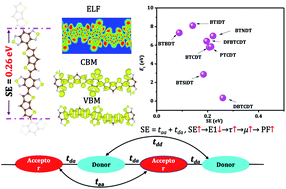Theoretical search for high-performance thermoelectric donor–acceptor copolymers: the role of super-exchange couplings†
Abstract
Donor–acceptor (D–A) copolymers are a type of prototypical conducting conjugated polymers with remarkably high mobility approaching 100 cm2 V−1 s−1, making them potential thermoelectric (TE) candidates. However, only limited pioneering experimental studies have been devoted to obtaining a microscopic understanding of the relationship between the atomic structure and TE properties of D–A copolymers, which hampered the effort to enhance their TE performance. As such, our work seeks to establish a comprehensive understanding of the intrinsic electronic, geometric, and TE properties of a series of D–A copolymer chains. By using density functional theory methods combined with Boltzmann transport and deformation potential theories, we found the strong intra-chain superexchange (SE) coupling to be a key indicator for high mobility and TE performance. Strong SE couplings induce not only small hole effective mass but also weak electron–phonon couplings, resulting in high mobility and high power factors. Furthermore, we provide a route to establish strong SE coupling and optimize the TE performance by minimizing the energy difference between the frontier molecular orbitals of the donor and acceptor moieties. Our work thus provides strong indications that D–A copolymers represent a class of systems with high potential in TE applications.



 Please wait while we load your content...
Please wait while we load your content...